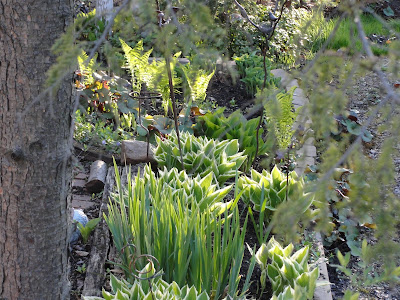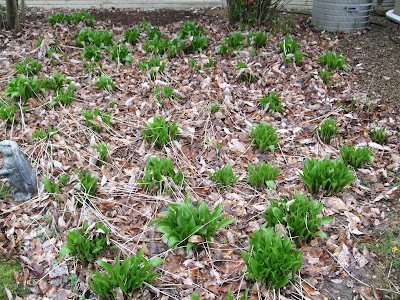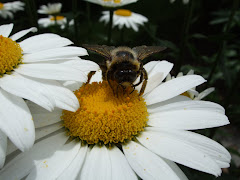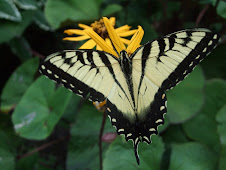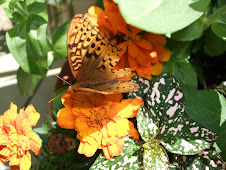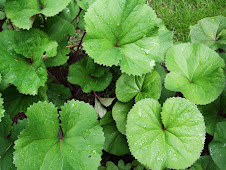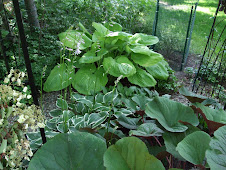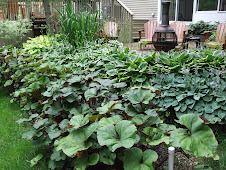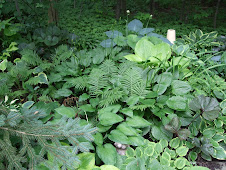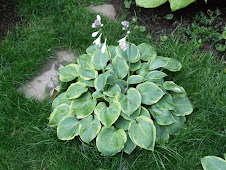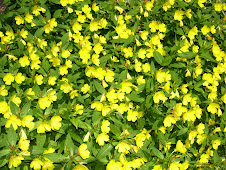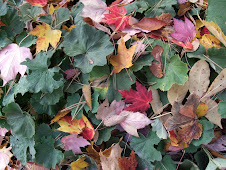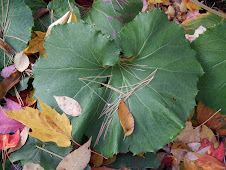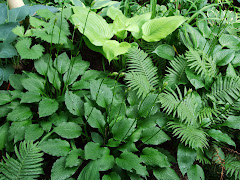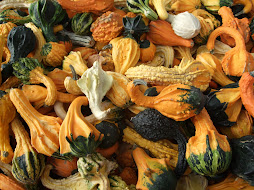
Friday, April 30, 2010
Wednesday, April 28, 2010
we got pumpkins, we got pumpkins
And a whole bunch of hosta, but first, the pumpkins.
Pat and I left an uncarved pumpkin, leftover from our Halloween decor, in the flower bed over the winter. The remains of the pumpkin got mixed in with the dirt and sweet peet when we enlarged the bed. Lo and behold! Little pumpkin plants started to push through about a week ago. How cool is that? It is a wonderment. It's the first vegetable we've grown (inadvertent or not) from seed. Pumpkins are a vegetable, aren't they? The vines will look really good wandering around the bed in the early fall. With luck, we'll have our own pumpkin collection in the fall. Or maybe the scourge of the earth, also known as rabbits, will eat them. Maybe rabbits don't like orange peels.
We still have hosta that haven't pushed through yet. I can tell by the circles of dirt here and there in the yard. As usual the lancifolia were the first up. What I always find interesting is that lancifolia are the last to flower. This hosta is great for path borders and mass plantings for a ground cover. A steady diet of leaf mulch and sweet peet allows us to split these guys every three years.

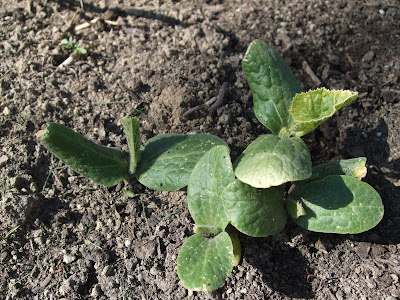
This guy spends the winter in the ground. We dig him out in late March. It sure looks like a giant green ice cream cone sitting in the soil tile. For some reason the deer ignore this one. The impatiens we used to plant in the soil tile were eaten to the nubs.

 Can you here me crying? I guess this hosta doesn't taste very good. I'm telling you, I have to figure out a way to get the Aztec in the back yard so I can chase the deer.
Can you here me crying? I guess this hosta doesn't taste very good. I'm telling you, I have to figure out a way to get the Aztec in the back yard so I can chase the deer.



This is mama hosta. Shirley, the mother-in-law, brought it with her on her first trip to Cleveland. The lancifolia is papa hosta. So I have Shirley to thank for this hobby or obsession. I guess it depends how you define having over 400 hosta. But you know, you can never have enough hosta.

Notice the fern between the hosta and the ligularia? We tried to remove all the ferns from the patio bed a couple years ago. Well you know how that worked. Ferns and ligularia have to get their growing done before the hostas unfurl. By June the hosta will crowd out everything that is shorter than them.
Pat and I left an uncarved pumpkin, leftover from our Halloween decor, in the flower bed over the winter. The remains of the pumpkin got mixed in with the dirt and sweet peet when we enlarged the bed. Lo and behold! Little pumpkin plants started to push through about a week ago. How cool is that? It is a wonderment. It's the first vegetable we've grown (inadvertent or not) from seed. Pumpkins are a vegetable, aren't they? The vines will look really good wandering around the bed in the early fall. With luck, we'll have our own pumpkin collection in the fall. Or maybe the scourge of the earth, also known as rabbits, will eat them. Maybe rabbits don't like orange peels.
We still have hosta that haven't pushed through yet. I can tell by the circles of dirt here and there in the yard. As usual the lancifolia were the first up. What I always find interesting is that lancifolia are the last to flower. This hosta is great for path borders and mass plantings for a ground cover. A steady diet of leaf mulch and sweet peet allows us to split these guys every three years.


This guy spends the winter in the ground. We dig him out in late March. It sure looks like a giant green ice cream cone sitting in the soil tile. For some reason the deer ignore this one. The impatiens we used to plant in the soil tile were eaten to the nubs.

 Can you here me crying? I guess this hosta doesn't taste very good. I'm telling you, I have to figure out a way to get the Aztec in the back yard so I can chase the deer.
Can you here me crying? I guess this hosta doesn't taste very good. I'm telling you, I have to figure out a way to get the Aztec in the back yard so I can chase the deer.


This is mama hosta. Shirley, the mother-in-law, brought it with her on her first trip to Cleveland. The lancifolia is papa hosta. So I have Shirley to thank for this hobby or obsession. I guess it depends how you define having over 400 hosta. But you know, you can never have enough hosta.

Notice the fern between the hosta and the ligularia? We tried to remove all the ferns from the patio bed a couple years ago. Well you know how that worked. Ferns and ligularia have to get their growing done before the hostas unfurl. By June the hosta will crowd out everything that is shorter than them.
Tuesday, April 27, 2010
Tuesday, April 20, 2010
Monday, April 19, 2010
an annual that's not
A couple of three years ago Pat had some vinca vines in a flower box on the deck rail. The vines did so good that the vines touched the ground. That's about 8 feet and the vines looked really cool, hanging gardens of Babylon cool. Somehow the vines took root and started growing from the ground. Now in zone 5b this type of vinca is an annual. The first good frost and our annuals turn to green mush. These guys kept coming back. In fact, they stay green through the winter. They are green when the snow covers them in December and green when the snow melts in March. It is a wonderment. Pat says that there must be some kind of micro-climate next to the deck or something. Now for the big question. What do you do with a vine that grows on the ground? We've been ignoring the what to do and just marveling at the plants resilience.

 I finally decided to do something about my plant ignorance. When I started working in the yard I had no intention of becoming a "gardener." After all, gardeners know what they are talking about. This is me, I never know what I'm talking about. I used to call it anarchist gardening. Finding a gardening home through Blotanical made me realize that I needed to improve my craft. I've actually paid attention to all you gardeners who have given me advice and guidance. I don't know where this tome stands in the must have garden book list. But it is BIG and it has lots of pictures for me to look at.
I finally decided to do something about my plant ignorance. When I started working in the yard I had no intention of becoming a "gardener." After all, gardeners know what they are talking about. This is me, I never know what I'm talking about. I used to call it anarchist gardening. Finding a gardening home through Blotanical made me realize that I needed to improve my craft. I've actually paid attention to all you gardeners who have given me advice and guidance. I don't know where this tome stands in the must have garden book list. But it is BIG and it has lots of pictures for me to look at.

 I finally decided to do something about my plant ignorance. When I started working in the yard I had no intention of becoming a "gardener." After all, gardeners know what they are talking about. This is me, I never know what I'm talking about. I used to call it anarchist gardening. Finding a gardening home through Blotanical made me realize that I needed to improve my craft. I've actually paid attention to all you gardeners who have given me advice and guidance. I don't know where this tome stands in the must have garden book list. But it is BIG and it has lots of pictures for me to look at.
I finally decided to do something about my plant ignorance. When I started working in the yard I had no intention of becoming a "gardener." After all, gardeners know what they are talking about. This is me, I never know what I'm talking about. I used to call it anarchist gardening. Finding a gardening home through Blotanical made me realize that I needed to improve my craft. I've actually paid attention to all you gardeners who have given me advice and guidance. I don't know where this tome stands in the must have garden book list. But it is BIG and it has lots of pictures for me to look at.Saturday, April 17, 2010
no yard work today
I wanted to spend all weekend in the garden. Mother Nature had other plans. It’s snowing! There must be some indoor project I’ve been avoiding. Now it’s not the pretty kind of snow everyone likes in December. It’s the wet kind of snow that sucks the joy out of a gardener. I know the old saying about April showers and May flowers. I don’t think it says anything about snow. The garden work can wait for another day.
These are some pics from the last couple of days. The yard is coming back to life. Oh! I do have an indoor project, new shelves in the pantry.
All is well with the world. Big Blue came back.
 Gloria Bonde at a healthy gardener gave me this great deer deterrent, orange peels. I now eat 2-3 oranges a day just for the peels.
Gloria Bonde at a healthy gardener gave me this great deer deterrent, orange peels. I now eat 2-3 oranges a day just for the peels.
These are some pics from the last couple of days. The yard is coming back to life. Oh! I do have an indoor project, new shelves in the pantry.
All is well with the world. Big Blue came back.
 Gloria Bonde at a healthy gardener gave me this great deer deterrent, orange peels. I now eat 2-3 oranges a day just for the peels.
Gloria Bonde at a healthy gardener gave me this great deer deterrent, orange peels. I now eat 2-3 oranges a day just for the peels. Wednesday, April 14, 2010
Monday, April 12, 2010
what's new
Spring is such a cool time of the year. A winter of anticipation is at an end. All the worry of whether something is going to come back is answered. Spring also brings pleasant surprises such as finding a brunnera in a railroad tie. Hope springs eternal for more than just baseball fans. Seeing our hard work poke through the ground brings a smile. The aches and pains of yard work disappear.
We got this guy is from the Wilmot Nature Center. They have a native plant sale every year combined with some great seminars. Lots of hiking trails, so bring a camera if you ever visit.

Our lungworts are a year old. They shriveled up after we planted them last year, but have come back rather well.


This brunnera seeded itself. I always wonder what to do with plants like this, leave 'em or move 'em. it looks really cool in the middle of the myrtle.


We got this guy is from the Wilmot Nature Center. They have a native plant sale every year combined with some great seminars. Lots of hiking trails, so bring a camera if you ever visit.

Our lungworts are a year old. They shriveled up after we planted them last year, but have come back rather well.


This brunnera seeded itself. I always wonder what to do with plants like this, leave 'em or move 'em. it looks really cool in the middle of the myrtle.


About half our hosta has broken through. Even though I know they will all come up, I still walk the yard every day looking. As if by my force of will, I can make all our plants come back. Pat just chuckles and reminds me that I do this every year and every year the plants come back.

 We inherited the quince. It's planted near the house facing north. So it gets no direct sun. How it got so big is a wonder to Pat and me. It is about 5 foot high and 2 foot across at the base. We have no experience with quinces. When should we cut it back and how do we promote more blooms?
We inherited the quince. It's planted near the house facing north. So it gets no direct sun. How it got so big is a wonder to Pat and me. It is about 5 foot high and 2 foot across at the base. We have no experience with quinces. When should we cut it back and how do we promote more blooms?




OK. I need help. Once again I saw something at a nursery that was calling my name. Problem is that I forgot the plant label, so I am clueless about what it is. I know that there are those amongst you that think I've lived most of my life in blissful cluelessness, but I really want to know what this guy is.

Just so you don't get the idea that my forgetfulness is an isolated event, I have another plant that I can't identify. This guy is supposedly related to the astilbe plant. We bought this plant at a garden club plant sale. One of the major dommos said that it was a ground cover. We planted one last year. This year four popped up.

 We inherited the quince. It's planted near the house facing north. So it gets no direct sun. How it got so big is a wonder to Pat and me. It is about 5 foot high and 2 foot across at the base. We have no experience with quinces. When should we cut it back and how do we promote more blooms?
We inherited the quince. It's planted near the house facing north. So it gets no direct sun. How it got so big is a wonder to Pat and me. It is about 5 foot high and 2 foot across at the base. We have no experience with quinces. When should we cut it back and how do we promote more blooms?



OK. I need help. Once again I saw something at a nursery that was calling my name. Problem is that I forgot the plant label, so I am clueless about what it is. I know that there are those amongst you that think I've lived most of my life in blissful cluelessness, but I really want to know what this guy is.

Just so you don't get the idea that my forgetfulness is an isolated event, I have another plant that I can't identify. This guy is supposedly related to the astilbe plant. We bought this plant at a garden club plant sale. One of the major dommos said that it was a ground cover. We planted one last year. This year four popped up.
Sunday, April 11, 2010
tulips
It's perfect work in the yard weather.It's in the 50's and the sun is out. We are in the yard clean-up and let's move plants around mode. I still have time to take pics to share. Katie and Sean picked these SilverStream tulips up from the Amsterdam Tulip Museum. They have leaves that echo the leaves of some of our hosta. Their blooms are very cool looking , but alas, they last only a couple weeks. Bummer. They are up against the house. With the new beds in the front yard, they are moving in the fall. Well, back out into the yard.
Friday, April 9, 2010
Jim and Pat's Sustainable Gardening
Jan of ThanksFor2Day asked garden bloggers to join in the Garden Bloggers Sustainable Living Project in celebration of Earth Day April 22. The theme of the blog project is sustainable living. Gardening and sustainable living would seem to go hand in hand. Upon reflection, I found that I couldn’t define sustainable living – the answer wasn’t as easy as I thought. A flashback of the 70’s raced through my head. I started singing the words of a John Prine song. “Blow up your TV, throw away your papers, move to the country…” I live in the suburbs and am addicted to the internet, so I’m not throwing anything away. But as a resident of NE Ohio, home of the famous (or infamous) Cuyahoga River fire of 1969, I thought that I needed to wade in.


Pat and I take part in all the normal environmental duties in which well meaning suburbanites partake. We recycle and have replaced our incandescent light bulbs with fluorescent ones, yippee. One thing we do that seems strange to our neighbors is that we never use our air conditioner, period.
How we work in our yard and garden is where we do our part for Mother Earth. We never water our turf grass. It is not worth the expense or trouble. No fertilizer is used on the turf grass. I let the grass grow to 3.5 inches or so, which deters most weeds; besides, I could never figure out when to spread what. We mow our leaves into the grass every fall, as added mulch. What we discovered when removing some sod for a new flower bed was that our benign neglect was actually beneficial. The roots reached down a good three inches, and the grass does well all season.

We installed rain barrels for watering our containers. In our garden we use only sweet peet (zoo poop and leaf humus) on the soil. I can’t speak highly enough about this local product. Luckily, Pat and I can populate new flower beds from existing plants and flowers. Recently we have concentrated on acquiring native plants. We are even trying our hand at suburban agriculture this year by starting a vegetable garden in what’s left of the backyard (thus reducing even more the amount of turf grass to maintain).

The 70s flashback blazes in my head again with an image of the Mother Nature poster and then I think I know what sustainable living is. Plant what grows in your area; that way you don’t have to waste water with unneeded watering. Opt for plants that propagate themselves. Don’t waste money on chemicals. If your pets can’t walk on it, why should you. And be nice to Mother Nature.
Subscribe to:
Comments (Atom)



